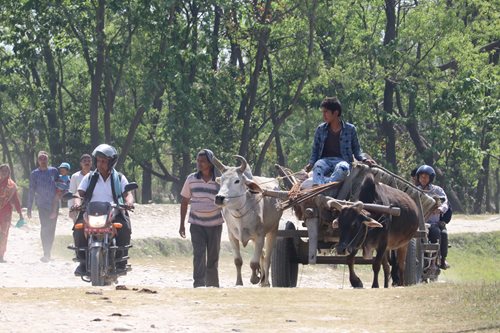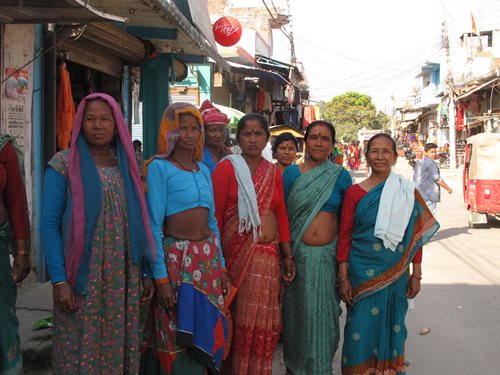Way back when our firstborn was four, his father Simon was leading the team of engineers and other specialists who were working to protect Rajapur Island from disastrous floods while also making agricultural irrigation more reliable. One monsoon Simon decided to make the journey to the northern tip of the island to see what conditions were like during the Monsoon, when the mighty Karnali River was in flood. Vehicle access was impossible during the rains, walking would have been arduous and probably hazardous too so Simon and Alexander made the journey in a buffalo cart. The 25-kilometre round trip took 12 hours. Getting to the island in the first place was, at that time, a fifteen-hour rough-road drive from Kathmandu or a flight to Nepalgunj and a three-hour drive. Then there was always quite a wait for the ferry to get onto the island.
Last week we went back to see how things had changed on Rajapur. The local chap who took us, casually mentioned the man from Tikapur who was taken by a tiger during the road improvements, which have been many. When we'd lived on the island, the gravel or dirt roads we had used had been punctuated by places where we had to drive down into drive river-beds; these places became impassable in the Rains. Now there are sturdy concrete culverts. In the days I described in "A Glimpse of Eternal Snows" and "Snowfed Waters" the only way to get onto the island was by various ferries. Now there are two long bridges onto Rajapur Island from the West and also from the East so it is easy to drive to Rajapur bazaar these days.
Indeed, we set out from Nepalgunj at eight in the morning, had an excellent rice and curry in the new Jamuna Hotel in Rajapur town and from there up to admire the irrigation intake structures at the tip of the island just a couple of hours later. There was not only a black-topped road but even petrol and diesel filling stations on the island.
On the way north, we paused to admire an electric fence designed to keep our marauding elephants and rhinos and we could see better facilities had arrived including electricity for many households. Life looked easier for the locals. Not knowing who we were, the proprietor of a tea-shop in Shanti bazaar even volunteered thoughts on how much better things were since the flood protection and irrigation works had been completed. How before there had been terrible floods, but no longer. Simon's project had been a success.
Rajapur still feels very rural and relatively untouched, though now vehicles and ox-carts vie for positions on the dirt roads, motorbikes with whole families on board speed past men on bicycles, often with a woman sitting side-saddle on the back-carrier, boys driving pairs of buffalo or oxen chatt on mobiles and there are lots and lots of smartly turned out children heading for school.
It all looked so lush. Fields of bearded winter wheat were nearly ready for harvesting and in a few fields women were transplanting rice seedlings. Yellow-flowered bushes said that there would be plenty of lentils grown locally too, as well as leafy vegetables.
What had changed? The river has moved again so that most of the flow is on the west of the island and I gather than the blind dolphins have gone, probably the gharials too. There is, as everywhere in Nepal, a lot of mining for stone and sand in the river.
Traditional dress is hardly worn by Tharu women any more, I guess the salwar kameez is a more practical outfit, though plenty of women wear saris, and that kind of full-length nightie that is easy to work in. Although many of the houses are still made of woven straw or bamboo plastered with a mud and cowdung mix, I didn’t see any with the lovely stylised relief animals that women used to adorn their house with. Wattle and daub homes clearly take a lot of maintenance so it is no wonder more people have elected to build with bricks; corrugated iron is more popular than thatch for rooves. As ever, people still plant plenty of flowers around their homes. Oh and there were no pigs that I noticed. There were plenty of goats and chickens of course, but I wonder what has happened to the Tharu taste for pork.
A second piece on this Rajapur trip is here:
Parenting in an idyll
 |
| Ancient and modern - ox-carts and motorbikes, in the north of Rajapur Island |
 |
These lovely ladies in Rajapur bazaar agreed to pose for me -
the woman second from the left is one of the few I saw wearing traditional Thau dress |